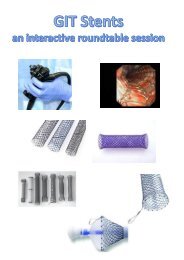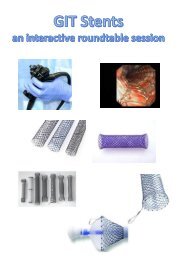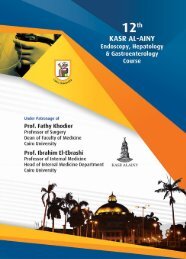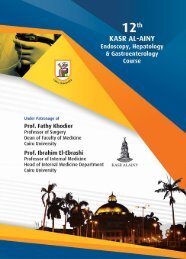You also want an ePaper? Increase the reach of your titles
YUMPU automatically turns print PDFs into web optimized ePapers that Google loves.
HEPATITIS E: WHAT’S NEW?<br />
Naglaa Zayed, MD<br />
Cairo University
■ Epidemiology<br />
■ HEV Genome<br />
■ Clinical Picture<br />
■ Diagnosis<br />
■ Treatment<br />
■ Prevention<br />
Agenda<br />
HEV <strong>What’s</strong> <strong>New</strong>
Known Facts: HEV<br />
■ 20 million HEV infections worldwide annually<br />
- 3.3 million symptomatic cases<br />
-70,000 HEV-related deaths<br />
■ Self-limiting, acute liver failure may develop.<br />
■ Transmitted via the faecal-oral route, via contaminated water.<br />
■ Highest prevalence in East and South Asia.<br />
■ Prevention: HEV vaccine, ??protective Igs against future reinfection.<br />
.Rein DB,et al. Hepatology 2012; 55(4):988-97.<br />
Lozano R, et al. Lancet 2012;380:2095-2128<br />
WHO. Viral <strong>Hepatitis</strong> July 2015
■ Higher in developing (10-70%) than developed countries (1-21%).<br />
■ Adults 15-40 years of age.<br />
Epidemiology of HEV<br />
■ Risk groups elderly men, pregnant women, young children,<br />
immunocompromised patients, CLD, contact with HEV-infected animals.<br />
Epidemic and Sporadic <strong>Hepatitis</strong><br />
in Endemic Areas<br />
Outbreaks<br />
Faecal contamination of<br />
drinking water supplies<br />
Sporadic Cases<br />
contamination of water or food<br />
Gust ID, Purcell RH. J Infect Dis 1987; 156:630.<br />
Villarejos VM, et al.Am J Epidemiol 1982; 115:577.<br />
Teshale EH, et al.Clin Infect Dis 2010; 50:1006.
Geographical Distribution of HEV<br />
Egypt: anti-HEV IgG<br />
45.2% (43/95) blood donors<br />
39.6% (38/96) haemodialysis patients<br />
https://www.cdc.gov/hepatitis/hev/hevfaq.htm<br />
Abdel Hady S et al. J Egypt Public Health Assoc. 1998;73(3-4):165-79.
■ Member of the Hepeviridae family.<br />
HEV Genome<br />
■ Small virus (27-34 nm in diameter)+ve-sense, non-enveloped singlestranded<br />
RNA genome, about 7.2 kilobases long.<br />
NS proteins; viral processing and replication<br />
Structural proteins<br />
Reyes GR, et al.Science 24713351339 Reyes GR, et al.Arch Virol 71525 Tam AW,et al. Virology 185120131<br />
Kumar S, et al. International Journal of Infectious Diseases 2913; 17(4): e228–33
HEV Genotypes<br />
Four genotypes/24 subtypes with different geographic distributions<br />
Kar P, et al.Am J Gastroenterol 10324952501<br />
Mizuo H, etal. J Med Virol 76341349
G5/6 Pigs G7 Camels<br />
HEV Genotypes
Modes of HEV Transmission<br />
Fecal-oral, Food-borne<br />
Contaminated water<br />
undercooked meat/<br />
Shellfish /vegetables<br />
Vertical or Perinatal<br />
transmission<br />
Limited data<br />
Perinatal morbidity and mortality<br />
TRANSMISSION<br />
Blood-borne<br />
In UK, 225,000 blood donations,<br />
79 HEV G-3 RNA +ve<br />
Breast milk??<br />
HEV isolated in breast milk<br />
during acute HEV(case report)<br />
Hewitt PE, et al. Lancet 2014; 384:1766.Khuroo MS,et al. Lancet 1995; 345:1025. Kumar RM, et al. Eur J Obstet Gynecol Reprod Biol 2001; 100:9.<br />
Romanò L, et al. J Hepatol 2011; 54:34. Ijaz S, et al. J Infect Dis 2005; 192:1166.<br />
Arankalle VA, et al. J Hepatol 2002; 36:417. Rutjes SA, et al. Emerg Infect Dis 2009; 15:381.
Blood donors In China(n=9069)<br />
Anti-HEV IgM Anti-HEV IgG HEV antigen<br />
Elevated ALT >40 IU/L<br />
n=5023<br />
Normal ALT<br />
n=4046<br />
Anti-HEV IgG 33.3%<br />
Anti-HEV IgG 29.4%<br />
Anti-HEV IgM 1.41%<br />
Anti-HEV IgM 1.46%<br />
HEV antigen +ve 1.23%<br />
HEV antigen -ve 0.17%<br />
HEV-RNA +ve in 6 donors with acute HEV<br />
Wang M et al. Transfusion. 2017 Feb;57(2):273-9.
Clinical Picture of HEV
Acute <strong>Hepatitis</strong> E<br />
Clinical Picture of HEV<br />
■ Self-limited acute infection, resolves within 2–6 weeks.<br />
■ Incubation period 15-60 days.<br />
■ Acute hepatic failure can develop in a small proportion of patients.<br />
■ Asymptomatic or minimally symptomatic.<br />
■ Clinical symptoms occur in 2-5%.<br />
Acute viral hepatitis<br />
Extrahepatic findings (wide range of neurological disorders)<br />
Perrin HB, et al. Emerging Infectious Diseases. 2015;21(11):1928-1934.
Complications of Acute HEV<br />
Acute Liver<br />
Failure<br />
Cholestatic<br />
<strong>Hepatitis</strong><br />
Chronic<br />
<strong>Hepatitis</strong> E<br />
Mortality<br />
Low 0.5%-4%<br />
Increase in young infants
HEV and Pregnancy<br />
In endemic regions<br />
■ Up to 70% of pregnant women progress to AHF in 2 nd & 3 rd trimester. 1<br />
■ Worse fetal and maternal outcomes.<br />
■ High mortality rate 15-25% in 3 rd trimester. 2<br />
■ HEV G-1 and 2, virulence of these human-specific viruses, hormonal and<br />
immunological changes.<br />
■ AHF and poor pregnancy outcomes not observed with G-3. 3,4<br />
1.Patra S, et al. Ann Intern Med 2007; 147:28. 2.Khuroo MS, et al. Am J Med 1981; 70:252.<br />
3.Anty R, et al. J Clin Virol 2012; 54:76. 4.Tabatabai J, et al. J Clin Virol 2014; 61:170.
Clinical Picture: Complications<br />
Acute Hepatic Failure(AHF) 0.5-4%.<br />
■ Pregnant, malnourished patients or those with preexisting liver disease<br />
(e.g HBV) may experience exacerbation; AHF and increased mortality.<br />
■ Characterized by hepatic encephalopathy, elevated aminotransferases and<br />
impaired synthetic function.<br />
■ High mortality (0.5-3%) if intensive care support and LT are not available.<br />
Aggarwal R. Semin Liver Dis 2013; 33:30.<br />
CDC.MMWR Morb Mortal Wkly Rep 1987; 36:241.
Clinical Picture: Complications<br />
Cholestatic <strong>Hepatitis</strong><br />
■ Prolonged cholestasis, protracted period of jaundice (>3 months), in up<br />
to 60% of patients with acute HEV.<br />
■ Asymptomatic or have symptoms of pruritus.<br />
■ Spontaneous resolution within weeks to months with no sequelae.<br />
■ Recovery is marked by viral clearance, an increase in IgG titers, and a<br />
decrease in IgM levels.<br />
Mechnik L, et al. J Clin Gastroenterol 2001; 33:421.<br />
Hoofnagle JH, et al. N Engl J Med 2012; 367:1237.
Chronic <strong>Hepatitis</strong> E<br />
Persistently elevated<br />
aminotransferase levels<br />
Detectable serum<br />
HEV RNA<br />
Histologic findings<br />
compatible with<br />
chronic viral hepatitis<br />
serum or stool HEV<br />
RNA> 6m<br />
Exclusively in context of solid organ transplantation,<br />
hematological disorders, immunosuppression(IS) or HIV
Chronic <strong>Hepatitis</strong> E<br />
Solid organ transplants (kidney, liver, and kidney-pancreas) 1-3<br />
■ Exclusively in G3-infected individuals.<br />
■ A cohort of 700 solid organ Tx recipients, 34 (5%) acquired HEV infection,<br />
of whom 47% developed chronic infection. 3<br />
■ Impaired T-cell responses, lower counts of lymphocytes, CD4 T cells; use<br />
of FK; low platelet count; younger age; LTx.<br />
■ Natural history not understood, rapid progression to cirrhosis. 1<br />
■ Risk for HEV reactivation.<br />
1.Gérolami R, et al. N Engl J Med 2008; 358:859.<br />
2.Khuroo MS and Khuroo MS. Curr Opin Infect Dis 2008; 21:539.<br />
3.Legrand-Abravanel F, et al. Emerg Infect Dis 2011; 17:30.
Chronic <strong>Hepatitis</strong> E<br />
Other Immunosuppressed hosts<br />
■ Case reports in patients with non-Hodgkin lymphoma receiving rituximab<br />
and in patients with HIV infection. 1,2<br />
■ Low risk of acute HEV compared with the general population.<br />
■ Failure to clear HEV and consequently develop chronic infection. 3<br />
1.Ollier L, et al. Ann Intern Med 2009; 150:430.<br />
2.Dalton HR, et al. N Engl J Med 2009; 361:1025<br />
3.Goel A, Aggarwal R. Expert Rev Gastroenterol Hepatol 2016; 10:1065.
HEV Diagnosis<br />
General approach<br />
■ Clinical suspicion in acute or chronic hepatitis that cannot be explained by<br />
other causes, particularly in the setting of known risk factors.<br />
■ Suspected among patients with rapidly progressive liver disease in pregnant<br />
women, patients with underlying CLD, solid organ transplant recipients, and<br />
hematologic malignancies.<br />
■<br />
Patients presenting with an elevation in aminotransferases & neurological<br />
manifestations.<br />
Wedemeyer H, et al.Gastroenterology 2012; 142:1388.<br />
Pawlotsky JM. Lancet 2014; 384:1729.
Diagnostic tests for HEV<br />
IgM anti-HEV<br />
Early phase of clinical illness<br />
Sensitivity 80-90% Specificity 92%<br />
IgG anti-HEV<br />
Appears shortly after IgM<br />
Persist as long as 14 yrs after acute illness<br />
HEV-RNA<br />
Appear early in stool<br />
Short-lived in acute infection<br />
Two real-time PCR assays
Centers for Disease Control and Prevention. www.cdc.gov/hepatitis/index.htm
HEV Diagnosis<br />
Acute HEV<br />
Chronic HEV<br />
Immuno<br />
competent<br />
Immuno<br />
compromised<br />
HEV-RNA in serum<br />
IgM anti-HEV<br />
HEV-RNA<br />
Baylis SA, et al. J Clin Microbiol 2011; 49:1234.<br />
Khudyakov Y, Kamili S. Virus Res 2011; 161:84.<br />
HEV-RNA in<br />
serum<br />
IgG anti-HEV Ab<br />
marker of exposure<br />
titers decline with time
Treatment of HEV<br />
Immune Status<br />
Stage of disease<br />
Acute HEV<br />
• Supportive treatment.<br />
• Fulminant hepatic failure require LTx.<br />
• RBV monotherapy in CLD patients & those on IS therapy or chemotherapy.<br />
• ??Improvement: spontaneous or due to RBV.<br />
Dalton HR, et al. Nat Rev Neurol 2016; 12:77.<br />
Del Bello A, et al. Transpl Infect Dis 2015; 17:279.<br />
Blasco-Perrin H, et al. Aliment Pharmacol Ther 2015; 42:574.
Treatment of HEV<br />
Acute HEV<br />
Significant improvement of liver functions<br />
Retrospective study in France<br />
Acute HEV G-3/ 4 (n=21)received RBV monotherapy for median 26 days<br />
IS therapy /chemotherapy was suspended in 6 patients<br />
All patients cleared HEV within 6 weeks<br />
median time to viral clearance of 29 days<br />
2 patients died from liver failure(underlying CLD)<br />
Péron JM, et al. Liver Int 2016; 36:328.
Treatment of HEV<br />
Chronic HEV<br />
Reduction of<br />
Immunosuppressive<br />
Therapy<br />
Antiviral<br />
Therapy(RBV)<br />
G3 & G4<br />
Eradicate HEV-RNA & achieving SVR<br />
SVR: absence of HEV-RNA 12 weeks<br />
after cessation of treatment<br />
SVR predictor: HEV-RNA 1 st week after therapy/Total lymphocyte count
Treatment of Chronic HEV<br />
Reduction of Immunosuppressive Therapy<br />
HEV-RNA in blood and stool after 12 weeks<br />
Viral clearance in 30% in a series of 85 recipients<br />
of solid organ transplants who had chronic HEV<br />
Kamar N, ]et al. Gastroenterology 2011; 140:1481.
Treatment of Chronic HEV<br />
■ 12-week course of RBV monotherapy (600 mg daily): 1,2<br />
-IS therapy cannot be reduced.<br />
-Persistent HEV-RNA despite a reduction in IS for 3 months. 1,2<br />
■ ??No RCT, only case series<br />
■ 59 solid-organ transplant recipients with chronic HEV-G3 received 3<br />
months of RBV monotherapy.<br />
Outcome<br />
HEV clearance 95% (n=56)<br />
SVR 78% (n=46)<br />
AEs<br />
Anemia: reduction in RBV dose (29%)<br />
EPO(54%), blood transfusion(12%) 3<br />
1.Wedemeyer H et al. Gastroenterology 2012; 142:1388.<br />
2.Kamar N. et al Clin Microbiol Rev 2014; 27:116.<br />
3.Kamar N, et al. N Engl J Med 2014; 370:1111.
Response to Antiviral Therapy<br />
Stool & serum HEV RNA at<br />
12 weeks<br />
Subsequent Management<br />
Undetectable<br />
HEV RNA<br />
Detectable HEV<br />
RNA serum±stool<br />
Relapse<br />
Treatment<br />
failure<br />
Stop RBV<br />
SVR 12<br />
Extend RBV 3m 1<br />
Initiate<br />
6m RBV 2 Follow Up 3<br />
3m PEG-IFN??<br />
1.Abravanel F, et al. Clin Infect Dis 2015; 60:96. 2.Kamar N, et al. N Engl J Med 2014; 370:1111. 3.Kamar N, et al. Clin Infect Dis 2010; 50:e30
Response to Antiviral Therapy<br />
RBV Therapy<br />
■ Up to 38% of treated patients do not how an SVR or even relapse.<br />
■ RBV dose reductions/Mutation in the viral polymerase (G1634R).<br />
Peg-IFN alfa<br />
■ Alternative treatment option if there is no contraindication.<br />
■ Peg-IFN for 3-12 months led to sustained clearance of HEV-RNA in<br />
chronic HEV who underwent LT.<br />
■ Cause significant adverse effects & organ rejection in transplant recipients.
Treatment of HEV: Future Therapy<br />
■ SOF inhibits HEV-G3 replication both in sub-genomic replicon systems<br />
as well as a full-length infectious clone.<br />
■ SOF+RBV results in an additive antiviral effect.<br />
■ More studies to explore antiviral potential of SOF+RBV, especially if<br />
RBV monotherapy fails.<br />
■ SOF as an add-on therapy to RBV for the treatment of chronic HEV in<br />
immunocompromised patients.<br />
Dao Thi VL, et al. Gastroenterology. 2016 Jan. 150(1):82-85.e4.<br />
Debing Y, et al. J Hepatol. 2016 Jul. 65(1):200-12
Monitoring for Toxicity<br />
■ Basic laboratory monitoring during and after HEV treatment.<br />
■ CBC at weeks 8 and 12 to evaluate for RBV-induced anaemia.<br />
■ Women of childbearing-age taking RBV, assessment of contraception<br />
use and pregnancy testing should be performed during and for 6<br />
months after treatment.<br />
■ Men taking RBV-containing regimen should be counseled on<br />
contraceptive use during and for 6 months after treatment.
Randomized trial in China, 112,604 healthy adults assigned to receive<br />
3 doses of HEV recombinant vaccine against G 1 and 4 (Hecolin)<br />
Protective efficacy over a 12-month period 96% 4<br />
Efficacy 4.5 yrs after the 1 st vaccination 87% 5 1.Zhang M, et al. Vaccine 2002; 20:3285.<br />
2.Tsarev SA, et al. Proc Natl Acad Sci U S A 1994; 91:10198.<br />
3.Khuroo MS, Dar MY. Indian J Gastroenterol 1992; 11:113.<br />
4.Shrestha MP, et al. N Engl J Med 2007; 356:895<br />
5.Zhang J, et al. N Engl J Med 2015; 372:914.<br />
Prevention of HEV Transmission<br />
Advice to<br />
travelers to HEV<br />
endemic regions<br />
Recombinant<br />
vaccines 1<br />
2,3<br />
Pre- or postexposure<br />
Ig prophylaxis??
Conclusion<br />
■ HEV is increasingly recognized as a pathogen in the developed world.<br />
■ Transfusion transmission of HEV is an emerging health risk, yet blood<br />
donors are rarely screened.<br />
■ HEV should be tested:<br />
-When you suspect drug induced liver injury.<br />
-Elevated liver enzymes with neurological manifestations or in immunocompromised patients<br />
■ Chronic persistent HEV infection may develop.<br />
■ Additional studies are needed to determine treatment regimens for HEV.

















